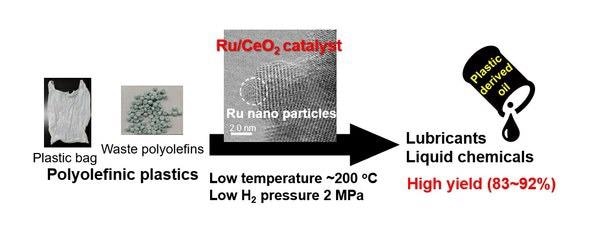Jan 6 2021
Scientists have used an innovative catalyst process to recycle a certain kind of plastic for the first time. This plastic is found in everything, such as food packaging, grocery bags¸ wax, liquid fuels, electronics and toys.
 Graphical abstract. Image Credit: Tamura/Osaka City University.
Graphical abstract. Image Credit: Tamura/Osaka City University.
The researchers published their results in the Applied Catalysis B: Environmental journal on December 10th, 2020.
“Plastics are essential materials for our life because they bring safety and hygiene to our society,” stated the co-authors of the study Masazumi Tamura, an associate professor in the Research Center for Artificial Photosynthesis in the Advanced Research Institute for Natural Science and Technology in Osaka City University, and Keiichi Tomishige, a professor in the Graduate School of Engineering in Tohoku University. However, the researchers said that the growth of the global plastic production and the rapid penetration of plastics into our society brought mismanagement of waste plastics, causing serious environmental and biological issues such as ocean pollution.
Polyolefinic plastics are known to be the most standard plastics. They have physical characteristics that make it hard for a catalyst—responsible for causing a chemical change—to directly interact with the molecular elements to induce a change.
Existing recycling efforts need minimum temperatures of 573 °K, and up to 1,173 °K. For comparison purposes, water boils at 373.15 °K, and the Sun’s surface is 5,778 °K.
The investigators considered heterogeneous catalysts in an attempt to identify a reaction that may need lower temperatures to activate. They used a catalyst that had a different state of matter than the plastics and proposed that the reaction would be more powerful at a lower temperature.
The team subsequently created a catalyst that caused the plastics to react at 473 °K. They achieved this feat by integrating ruthenium, a metal belonging to the platinum family, with cerium dioxide, which is utilized to polish glass among other different applications.
Although the new catalyst was still high, it needs considerably less energy input in comparison to other catalyst systems.
Tamura believes that ruthenium-based catalysts have never been described in the scientific literature as a means to instantly recycle polyolefinic plastics.
"Our approach acted as an effective and reusable heterogeneous catalyst, showing much higher activity than other metal-supported catalysts, working even under mild reaction conditions. Furthermore, a plastic bag and waste plastics could be transformed to valuable chemicals in high yields."
Masazumi Tamura, Study Co-Author and Associate Professor, Research Center for Artificial Photosynthesis, Advanced Research Institute for Natural Science and Technology, Osaka City University
The team used the new catalyst to process a plastic bag and waste plastics and created a 92% yield of valuable materials, including a 15% yield of wax and a 77% yield of liquid fuel.
"This catalyst system is expected to contribute to not only suppression of plastic wastes but also to utilization of plastic wastes as raw materials for production of chemicals."
Masazumi Tamura, Study Co-Author and Associate Professor, Research Center for Artificial Photosynthesis, Advanced Research Institute for Natural Science and Technology, Osaka City University
Others who contributed to the study include Yosuke Nakaji, Shuhei Miyaoka, and Yoshinao Nakagawa, all affiliated with the Graduate School of Engineering at Tohoku University; and Shogo Kumagai, Mifumi Tanji, and Toshiaki Yoshioka, all affiliated with the Graduate School of Environmental Studies at Tohoku University.
The study was financially supported by the Environment Research and Technology Development Fund of the Environmental Restoration and Conservation Agency of Japan.
Journal Reference:
Nakajia, Y., et al. (2021) Low-temperature catalytic upgrading of waste polyolefinic plastics into liquid fuels and waxes. Applied Catalysis B: Environmental. doi.org/10.1016/j.apcatb.2020.119805.